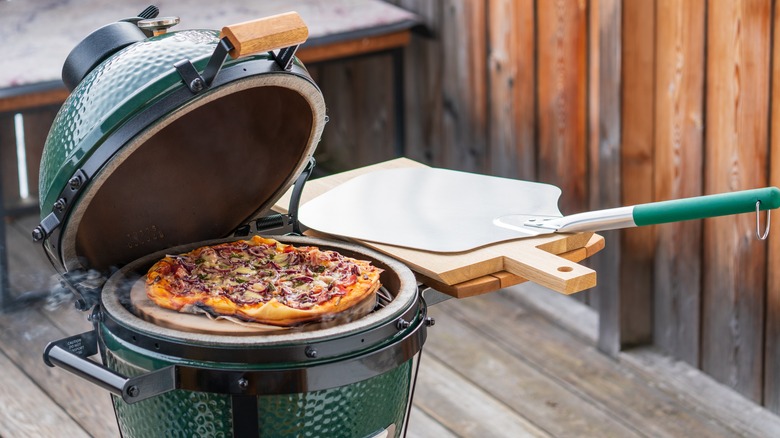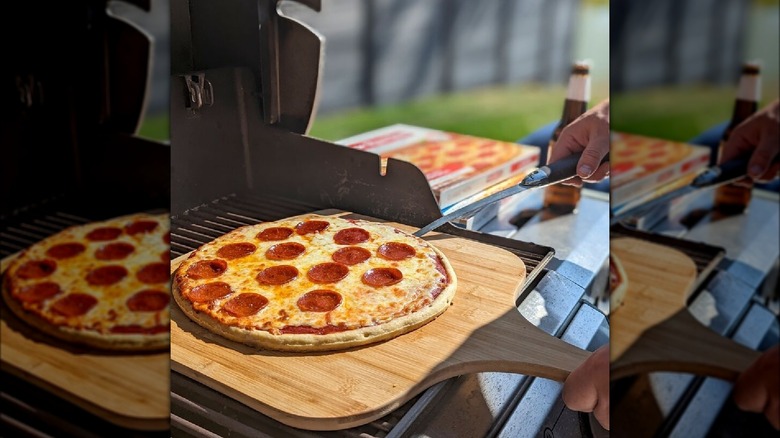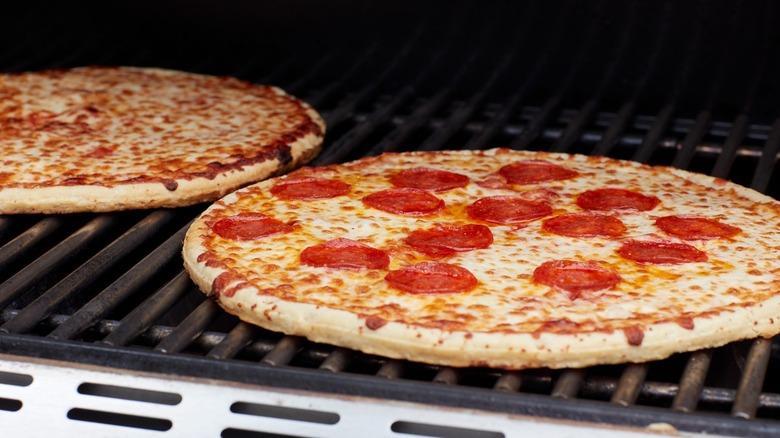Your Grill Turns Boring Frozen Pizza Into Something Extraordinary
If you've ever found yourself hungry at the end of a long day of work, but didn't want to spend money on take-out or dining at a restaurant, there's a good chance you wound up as one of the 200+ million Americans who report eating frozen pizzas each year, according to Statista. And while a nice FroPo might hit the spot every now and then, there's no denying that it usually pales in comparison to a pizza bought from the local pie shop, or one you make from scratch. Thankfully, there's a way to improve your frozen pizza, and it's a simple matter of changing how you cook it.
While almost all frozen pizza instructions call for baking the pizza, it turns out that a number of people have had great success grilling their frozen pizzas instead. Why does it work? The higher heat of a grill can result in an extra crispy crust, and if you're using charcoal, it can also add a nice smoky flavor to the pizza that can help make up for any other flavors that might otherwise be lacking. This method works especially well on thin crust pizzas, which cook up quickly, and standard thickness pizzas. Frozen deep-dish pizzas or extra large pies (think Costco-sized pizzas) tend to be trickier to cook on the grill because they need to be cooked longer and at a lower temperature.
How to grill frozen pizza
Cooking pizza on the grill can be a little nerve-wracking, but with frozen pizza, you have a bit of a buffer. While raw pizza dough can slip through the grates of your grill if it's not hot enough, or stick to the grates stubbornly, frozen pizza is rigid and usually par-baked so the dough already has more structural integrity than one that's raw. Ultimately, a frozen pizza should hold its shape when thrown on the grill.
Methods vary, but to grill your frozen pizza, you should pre-heat your grill to at least 350 degrees Fahrenheit or medium heat for a standard crust pizza. Some people recommend as high as 425 degrees Fahrenheit, but you'll need to open the grill regularly to check on the pizzas, which can cause the temperature to drop. For thin-crust pizza, you can get the grill up to high heat.
Once your grill is pre-heated, place the frozen, unthawed pizza on the grill, close the lid, and cook until the crust is crisp and brown on the bottom, and the cheese is melted on top. As with cooking any food on the grill, you might need to move the pizza around to avoid any hot or cold spots, and you should check it regularly to make sure the crust doesn't burn. Another benefit to grilling frozen pizza? Since the grill is already going, you can throw on extra items — peppers, onions, meat — then chop them up once they're sufficiently cooked and add them to the top of your pizza.
Grilled take-and-bake pizza and leftovers
There are two other ways to combine the powers of frozen pizza and the grill into a delicious dinner. Depending on where you shop, you may have seen preassembled, uncooked pizzas (called "take and bake" pizzas) for sale at your local grocery store like Mama Cozzi's at Aldi or Papa Murphy's. Stock up on these when they're on sale, then freeze them, and you can cook them on the grill when needed.
And what about leftover frozen pizza, or any leftover pizza, for that matter? It might not be worth it to fire up the grill for just a slice or two, but if you're already grilling and have some leftover pizza on hand, throw it on the grill. The hot air in the grill will melt the cheese and warm the toppings without burning them (which can happen in the toaster oven or broiler), and the crust will get warm and crispy on the bottom thanks to the dry heat, rather than getting soggy or hard as a rock in the microwave. It's a great way to warm up leftovers if you're already grilling.
Frozen pizza might be a meal that many of us rely on when we don't have the time or money for something else, but cooking it on the grill can take just as little time as using the oven while improving the flavor and texture so much that you might not even miss ordering delivery.


